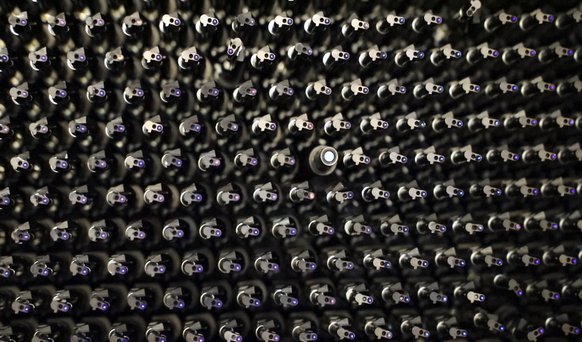May 19 2021
At the Kitt Peak National Observatory near Tucson, Arizona, a five-year search for mapping the Universe and untangling the secrets of 'dark energy' commenced officially on May 17th, 2021.
 Photo of a small section of the DESI focal plane, showing the one-of-a-kind robotic positioners. The optical fibers, which are installed in the robotic positioners, are backlit with blue light in this image. Image Credit: DESI Collaboration.
Photo of a small section of the DESI focal plane, showing the one-of-a-kind robotic positioners. The optical fibers, which are installed in the robotic positioners, are backlit with blue light in this image. Image Credit: DESI Collaboration.
To complete its search, the Dark Energy Spectroscopic Instrument (DESI) will capture and investigate the light from tens of millions of galaxies and other faraway objects present in the Universe.
DESI is an international science collaboration that has been controlled by the Lawrence Berkeley National Laboratory (Berkeley Lab) with main financial support received from the U.S. Department of Energy (DOE) Office of Science.
The Chinese Participant Group (CPG) set up by the National Astronomical Observatories, the Chinese Academy of Science (NAOC), has joined hands with the DESI collaboration via the imaging contribution of the Beijing-Arizona Sky Survey (BASS).
The BASS team at NAOC has spent about five years in collecting the astronomical images in the northern sky, which paves the way for the DESI spectroscopic survey. Now the DESI sets sail to explore the universe. The DESI is a really spectra factory that can collect 5,000 spectra every 20 minutes.
Hu Zou, Duty-PI of BASS and NAOC Representative, Dark Energy Spectroscopic Instrument
According to the researchers, by collecting light from nearly 30 million galaxies, DESI will help them build a 3D map of the universe with unparalleled detail. The data will help them gain better insights into the repulsive force connected with 'dark energy' that forces the speeding up of the expansion of the universe throughout huge cosmic distances.
The question is what makes DESI different from early sky surveys. According to the project director, Berkeley Lab’s Michael Levi, “We will measure10 times more galaxy spectra than ever obtained. These spectra get us a third dimension.”
He explained that rather than collecting two-dimensional images of quasars, galaxies, and other distant objects, the instrument gathers light, or spectra, from the cosmos such that it “becomes a time machine where we place those objects on a timeline that reaches as far back as 11 billion years ago.”
It’s been a long journey from the first steps that we took almost a decade ago to design the survey then to decide which targets to observe, and now to have the instruments so that we can achieve the science goals. It's very exciting to see where we stand today.
Nathalie Palanque-Delabrouille, Project Co-Spokesperson, Dark Energy Spectroscopic Instrument
The group leader of the Sky Survey and TMT Development at NAOC, XUE Suijian, stated, “Scores of researchers around the world have tested thousands of DESI’s component parts and validated the survey. After completing the imaging surveys, NAOC members have been involved in the DESI commissioning and survey validations during the past two years.”
The official commencement of DESI’s five-year came right after a four-month trial run of its custom instrumentation that could capture spectra from four million galaxies over the integrated output of all earlier spectroscopic surveys.
The DESI instrument consists of 5,000 robotically regulated optical fibers to collect spectroscopic data from a similar number of objects. Spectra that have been gathered by DESI are the components of light matching the rainbow’s colors.
Their characteristics, such as wavelength, disclose information like the chemical composition of objects being surveyed as well as information regarding their velocity and relative distance.
With the expansion of the Universe, galaxies tend to travel away from each other, and their light is transferred to longer and redder wavelengths. The farther the galaxy, the higher is its 'redshift.'
By quantifying galaxy redshifts, DESI scientists will make a 3D map of the Universe. The elaborate distribution of galaxies in the map is anticipated to provide a new understanding of the nature and impact of dark energy.
Additionally, NAOC astronomers will participate in the DESI observing, collaborate with researchers from the DESI collaboration, and use the DESI spectra to comprehend the unique kinds of stars and galaxies, cosmology, and galaxy evolution, etc.